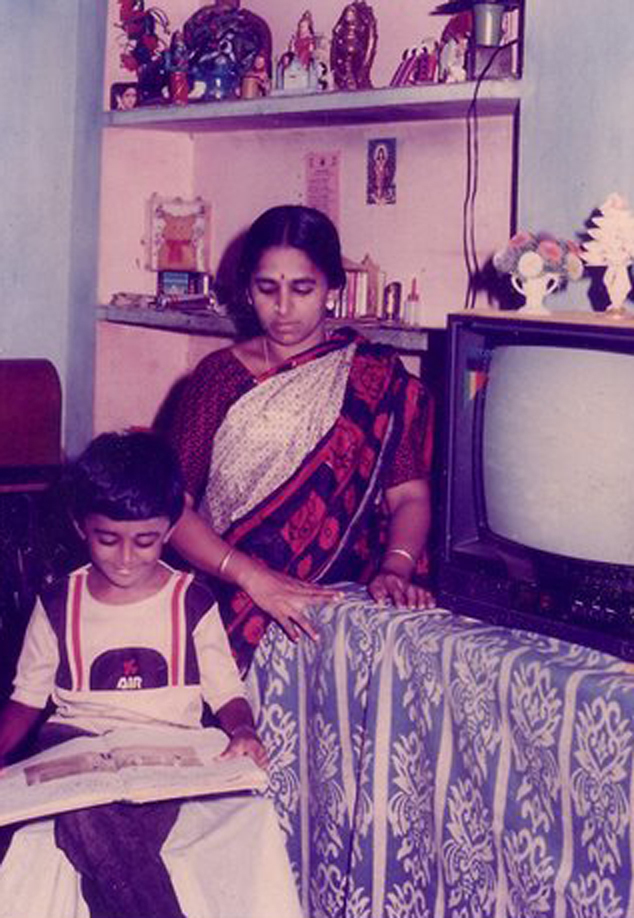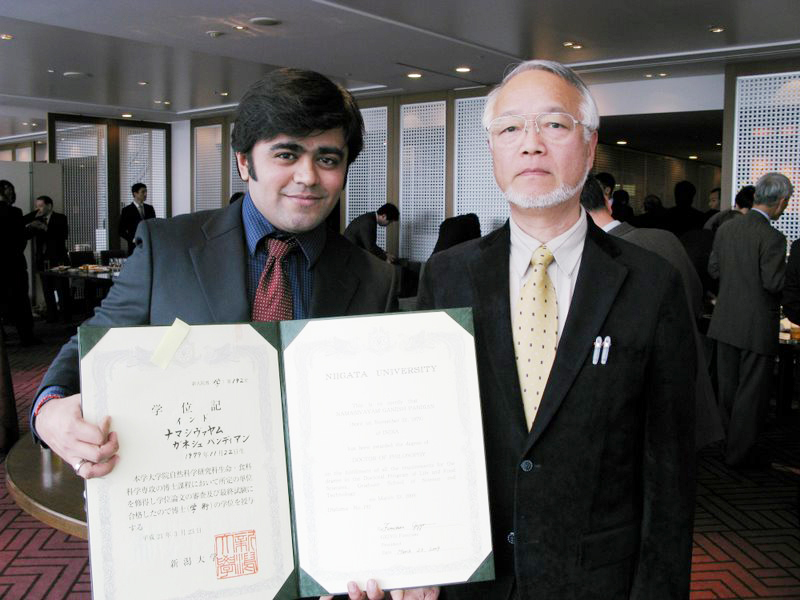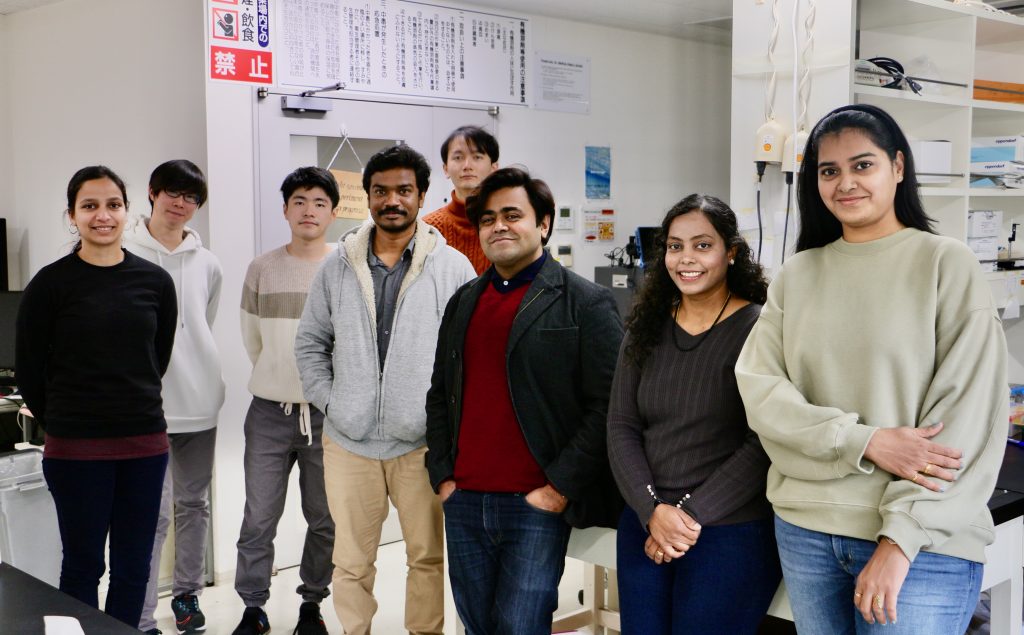Smart genetic switches for precision medicine
Epigenetic information can change how a DNA sequence is read without changing the sequence itself and plays a pivotal role in maintaining cellular identity. Developing designer molecules that can read and bind to specific DNA sequences is a technique used to turn on and off the expression of selected genes without altering the sequence itself. Decoding the natural genetic switches and creating “Smart Genetic Switches” by mimicking them is an emerging approach to treat genetic disorders. Ganesh’s group has found a way to work with mitochondrial DNA as well, advancing a whole new field called “transcription therapy” with potential in precision medicine for healthy ageing.
Junior Associate Professor / PI
Ganesh Pandian Namasivayam
Ganesh Pandian Namasivayam
“For the young people who want to be researchers, I encourage them to ask uncomfortable questions like ‘why not?’. ‘Why?’ can tell you the known unknown; ‘why not?’ can tell you the unknown-unknown and switch you to enter uncharted territory.”

Born in Tirunelveli, Tamil Nadu, India. Received his master’s in biotechnology from, University of Madras, India. PhD in applied biosciences from Niigata University. Began as a Research Associate at iCeMS in the Sugiyama Lab (2010–2014) before becoming a Program-Specific Assistant Professor (2014) and then Assistant Professor (2018). He now leads his own research group at iCeMS, as well as serving as a visiting scientist for the AO Research Institute, Switzerland, a visiting Professor, at KiBum Lab, Rutgers University, and a Scientific Advisor for Regugene Co Ltd.
Questioning everything!

“When I was about 12 years old, I had a problem in my eyes. And I had to be at home for about one year.” So as a kid, without the distraction of screens and the temporary inability to read and see the light, Ganesh began to observe nature and ask his mother questions. “I bothered my mother with so many questions and I just wanted to make conversation with her. So, I asked her, what are you cooking today? And then I asked, why are you cooking this today? Then I ask, why not cook this today? Like that, I keep bothering her with so many questions actually and she gets annoyed.”
At one point, Ganesh became sick and his mother told him, “You have played in such a bad environment, that's why you got a fever.” Ganesh kept a silkworm as a pet and wanted to know, “I have a fever, then why does the silkworm not have a fever? I mean, all these insects, if you see, live in an awful environment filled with pathogens but still survive without any special measures. So, that time I asked this question, so why don't the insects get sick?”
“So, among the many annoying questions, this was one sane question that I asked my mother, and she answered it with this question. ‘So why don't you become an adult and find the answer by yourself?’”
Communicating in a Common Language
Ganesh is a natural storyteller, whether talking about his life in person, discussing his research in a TEDx talk, or appearing on television webcasts to explain about the science behind COVID-19 in India, he speaks in a gentle, relaxed tone inviting the listener into his tale. He attributes his skill in communication to an ability to align with his audience, find a common language, and present the information in a way that the audience can hear and understand. He says that he learned many of his presentation skills through training at iCeMS, though clearly, he has a natural knack for communication and curiosity, which keeps him asking questions of the people and the world around him.
Asking questions and seeking answers seems to have set Ganesh on the path to becoming an iCeMS PI from an early age.
Paradise Regained

Ganesh soon recovered and was able to read and see the light comfortably. “I started to read with all my heart because then it's like paradise regained, right? So, I was super focused and started to study hard and wanted to be a researcher who not just asks – but answers questions.”
Ganesh first became acquainted with DNA through the movie Jurassic Park, where an animated “Mr. DNA” explains how he was extracted from a mosquito and used to create a dinosaur. “The moment I saw DNA, I fell in love with the molecule. So, I always had this fascination to work with DNA and then I pursued my career in biology.” After receiving a master’s degree in biotechnology in India, Ganesh came to Niigata University, Japan to pursue his PhD. Following his mother’s advice, he wrote his thesis on revealing one of the immune mechanisms in insects that help them not to get sick by pathogens.
From Bugs to Bacteria

While working on his PhD, Ganesh pondered a new question. “Do bacteria get sick?” People usually associate bacteria with infections and diseases; however, an astounding number of bacteria live in our gut and play a fundamental role in our physical and mental health. He learned about the CRISPR-Cas system discovered in bacteria as a DNA sequence-specific adaptive mechanism to resist plant RNA viruses. “Because CRISPR-Cas systems are something where you take the gene out and edit it and put it back, I wanted to explore an alternate system that can be taken in a simple tablet form.”
Pyrrole–imidazole polyamides (PIPs) are another group of molecules derived from bacteria, this time Streptomyces. “Basically, these two letters – pyrrole and imidazole, the heterocyclic compounds, can read the four letters of the DNA. Prof Hiroshi Sugiyama here at iCeMS is one of the world leaders in PIPs and was looking for a biologist who can advance biological applications of PIPs for cell fate control. So, that's how my journey started here at iCeMS.”
Ganesh joined the Sugiyama Lab in 2010, conjugating sequence-specific PIPs with the molecules that can edit the epigenome, making PIP like an on/off gene switch. “These types of chemicals with dual functionality could permeate live cells and regulate gene expression without altering the sequence. They can be designed to either express or suppress a particular gene of interest. If we get the target right, for example, a key regulatory gene, we can control the cell fate or reverse it from the diseased to the normal state. We made different versions of PIPs to switch ON and OFF the therapeutically important and cell fate governing genes.”
Music and Noise
“Here at iCeMS, we try to make our presentations as simple as possible. When I practiced my presentation in my home in front of my daughter, I repeatedly mentioned ‘genetic switch or epigenetic switch,’. She must have seen something on the iPad or somewhere that mitochondria are the powerhouse of a cell. So, she took a simple literal meaning and asked if it is a switch, why doesn’t it work on the cell’s powerhouse? Then I thought, okay, maybe I should work on a genetic switch for mitochondria and discussed it with a cerebral bachelor student (now Dr. Takuya Hidaka). That motivated me to expand my research and create my research domain to decode and recode genetic switches.”
Ganesh began his research on genetic switches at iCeMS with the Sugiyama Group in 2010. After becoming an Assistant Professor in 2016, Ganesh formed his own lab in 2018.
“Our lab is interested in decoding the genetic switches and creating biomimetic, smart (=programmable molecular recognition) switches for regulating gene expression. If you look at the molecular level, cells are made from the letters or DNA molecules A, T, G and C, located inside either the nucleus or the mitochondria. Our cell`s natural switches called transcription factors make a script or RNA out of these letters at the right place and time to maintain the normal function of cellular machinery. When all is well and the transcription is smooth and normal, you can imagine that as a piece of music. However, when there is an external change or an error in these letters, the natural switches fail to transcribe these letters properly, then the fate of the cell goes wrong into a diseased state, which can be imagined in terms of noise. We try to first identify the noise causing factors and edit them so that the noise is switched back to music and the letters are transcribed smoothly and normally. This kind of switching the transcriptional status of a cell from the noisy or diseased to the normal or musical state in a gentle manner where only the script and not the letters are altered is called “Transcription therapy”.
Speaking the Language of Bacteria
“My particular interest is in mitochondria. Whenever people think about the DNA, they always think about the nucleus, but the mitochondria that houses its own DNA (mtDNA) is often overlooked.” Mitochondria are found in every cell of the human body except for red blood cells and are essential for a cell to function normally. Nuclei and Mitochondria have many DNA repair mechanisms, but there are fewer in the mitochondria. This can lead to uncorrected errors or mutations and may ensue diseases.
Mitochondria are widely believed to have originated as prokaryotic cells which formed an endosymbiotic relationship within another one celled organism. “Mitochondria are basically bacteria. So, if we want to talk to mitochondria, we have to speak in a molecular language that they understand.”
PIPs were able to enter the cell nucleus but were unable to access mitochondrial DNA. By combining PIP with a mitochondria-penetrating peptide (MPP), Ganesh’s team has been able to develop a type of smart genetic switches called MITO-PIPs that can access a key sequence in mtDNA of a live cell and alter the transcription status of a particular gene. This innovation could open the way for new forms of treatment for mitochondrial diseases. “What we did in 2017 was to show that the access is possible but recently, we improved them to eliminate the mutated letters and switch the transcription back to the musical or normal state from noisy or abnormal state. Encouraged with this recent development, we are now looking at modulating the mitochondria-nuclear connection to delay cellular senescence”.
Currently Ganesh’s lab is pursuing collaborations with other iCeMS groups. “To advance our smart genetic switches, we need to have a closer look at how the transcription operates not just at the right place but at the right time. My group currently harnesses machine learning algorithms to make guided decisions to time our target. Moreover, we are also complementing the machine learning algorithms of a pocket-sized sequencing device with selectively reactive chemical probes to identify the epigenetic factors that decide the transcriptional status of nuclear and mitochondrial genes.”
Ganesh hopes his research will help advance treatment options. “The contemporary evidence-based medicine approach has dramatically reduced the adverse effect and the chances of failure of the previous symptom-based medicine approach and notably improved the success rate in treating modern-day diseases. Our group hopes to play a small role in the genetic knowledge-based precision medicine approach that is proclaimed to treat the current intractable diseases. Conventionally, the therapeutic approaches are targeted towards protein-protein interactions that often result in a transient effect and may vary among patients.”
He adds, “The transcription therapy approach may be beneficial as it can achieve a long-lasting impact with consistency across the patients. Furthermore, the recent approval of nucleic acid-based therapeutics to treat communicable and non-communicable diseases motivates us to travel in this direction. My particular interest is to develop tools for achieving healthy ageing.”
Advice for Young Researchers

“All disciplines are essential, but the world now needs more scientists, which is even more evident in this pandemic era. Modern science and technology facilitate a comfortable life where we already have most of the recommended things that we need. But our health is not just recommended but required. So, if you are not going to be in good health, then whatever the technological advancement that we are going to do, it's not going to be useful for us. So, I recommend that students take research as their career and encourage them to become scientists with a special emphasis on healthcare.”
“Researchers need to have this kind of a fusion field. One hundred years ago, we were all called scientists and scholars. For example, the father of Genetics, Gregor Mendel, was a mathematician. But over the years, people started to specialize in a particular discipline. Okay, we want to be a biologist, we want to be a physicist, we want to be a chemist and mathematician, and so on. But history tells us that the great discoveries are often the result of synergistic integration of these fields resulting in new disciplines. So the students need to be open-minded and switch to learn new things outside their comfort zone without any fear of failure. Research is not easy. One needs to go from one failure to another without losing interest and focus on achieving the target. Although uncomfortable, endurance is a worthy virtue.”